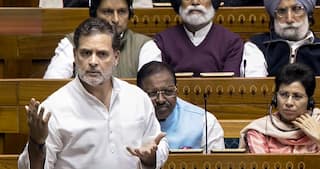$5 Trillion Economy By FY27? How Feasible It Is, What Will Drive This And What Stands In The Way
Experts are of the view that the nominal GDP needs to clock 9-10 per cent consistently in dollars terms to make India a $5-trillion economy by FY26-27

India has set its sights on becoming a $5 trillion economy in a few years from now. Prime Minister Narendra Modi first shared this vision in 2019, when he said the milestone will be achieved by 2024-25. However, the world economy has since gone through a major upheaval caused by the Covid-19 pandemic, besides other factors. Earlier this year, Chief Economic Adviser V Anantha Nageswaran said India would become a $5 trillion economy by 2026-27. Subsequently, the International Monetary Fund (IMF) made a similar projection after “correcting” its previous projection of 2028-29 for this goal to be achieved. Former RBI Governor D Subbarao, however, is still of the view that India could become a $5 trillion economy only by 2028-29, that too if it grows at 9 per cent for five years.
What Fiscal Numbers Say
India’s GDP in real terms grew 8.7 per cent in the fiscal 2021-22 as compared to a contraction of 6.6 per cent in FY20-21 and a slower growth of 3.67 per cent in 2019-20. The GDP at current price is estimated to be Rs 236.65 lakh crore in 2021-22 as against Rs 198.01 lakh crore in 2020-21 and Rs 200.74 lakh crore in 2019-20. According to the Union Budget of 2022, it is expected that it will reach Rs 258 lakh crore or almost $3.16 trillion (1USD=81.61INR) in 2022-23.
Moreover, in the first quarter of the financial year 2022-23 (Q1FY23), GDP data showed a double-digit growth of 13.5 per cent at a time when all leading global economies are struggling. The GDP has surpassed the pre-Covid level (2019-20) by 3.84 per cent. The first quarter data shows that the economy is on the growth trajectory to achieve the target of a $5 trillion economy.
The GDP of the first quarter of FY23 swept the board and stands at Rs 64.95 lakh crore at current price against Rs 51.27 lakh crore, 38.73 lakh crore and 49.42 lakh crore during the same period in FY22, FY21 and FY20, respectively. All sectors of the economy such as agriculture, service, manufacturing and constructions are doing really well.
Major Drivers
There are four major drivers of GDP. The first driver is private consumption represented by private final consumption expenditure (PFCE). It is the biggest chunk of the Indian economy. Data suggests that the share of private consumption has been declining during covid pandemic. PFCE as a share of nominal GDP slipped to 60.8 per cent in FY22 from 61.0 per cent in FY21. It is a clear indication of a sustained slowdown in private consumption during the Covid19 pandemic. However, due to the fastest economic recovery against the world's major economy with adequate policy support, it is doing better than expected. It reached pre-pandemic levels in FY22 and has now surpassed it in Q1FY23.
In nominal terms, it stands at Rs 140.95 lakh crore in FY22 against Rs 120.33 lakh crore in FY21 and Rs 122.37 lakh crore in FY20. PFCF in the first quarter of the financial year 2022-23 is increased by 10 per cent in real terms. It has reached to Rs 39.71 lakh crore at current price in the first quarter of the 2022-23 against the pre pandemic level of Rs 22.96 lakh crore during the same period in FY20. Private consumption is a major indicator of increasing demand in the market. The data reveals a sustained increase in household consumption despite pandemic disruptions. Recovery in demand may be seen in the growth rate of gross fixed capital formation.
The second most crucial driver is private investment. It is represented by gross fixed capital formation (GFCF). A strong investment climate is critical to achieve the goal of a $5 trillion economy. The economic survey 2018-19 laid out the role of private investment in driving demand, increasing productivity, development of new technology and generating employment. The government has taken several steps, like relaxing FDI norms, cutting corporate tax rates and accelerating infrastructure creation in order to boost investment. However, due to Covid19 the investment showed a declining trend from 29.5 per cent in FY19 to 26.6 per cent in FY21; thereafter GFCF improved to 27.8 per cent. in FY22. The growth rate of gross fixed capital formation is 20.1% over the corresponding quarter of the previous year. It is, according to the RBI, a reflection of a sharp acceleration in proximate coincident indicators like steel consumption, cement production and import of capital goods.
The third driver is investment made by the government via increasing capital expenditure. It is represented by the government final consumption expenditure (GFCE). During the Covid19 period when private consumption was at the lowest and private investors were shying away, the government came forward and started spending on infrastructure. The government investment as a share of nominal GDP jumped to 12.1 per cent in 2020-21 from 11 per cent in 2019-20. It is still at a higher level at 11.1 per cent in 2021-22.
However, the matter of concern is the fourth driver that is net exports. Net exports are on its knees due to continuous appreciation in the value of the dollar, increase in the price of crude oil and increase in imports. Net exports contributed negatively in Q1FY23 as the growth of imports outpaced the growth of exports.
High Frequency Indicators
Robust performance of high frequency indicators of economic activity in the current fiscal indicates continued recovery and sustained growth in the forthcoming quarters. High frequency indicators (HFI) show moderation in economic activities amidst slow global economy and high inflationary pressure. HFI, like passenger vehicle sales for urban demand, two-wheeler/ three-wheeler sales and tractors sales for rural demand, steel consumption and cement production for construction, manufacturing & services for PMI index, and tourist arrival, e-way bill, port cargo traffic, commercial vehicles sales, railway freight traffic for trade hotel transport, etc are indicating moderation in economic activities.
Challenges Ahead
The pandemic period was the worst of times not only for India, but for the world as well. Nevertheless, with adequate policy response, the Indian economy is on the path of recovery. However, rising inflation, supply chain disruptions, falling value of rupee, geo-political tensions and a slowdown in the global economy is tapering recovery.
The World Bank has lowered its GDP growth forecast for the country in the current fiscal for the second time. It had cut the economic growth forecast from 8.7 per cent to 6.5 per cent. In the same vein the IMF has also revised India’s growth projection for 2022. It lowered the growth projection and kept it at 6.8 per cent.
Foreign investors may remain cautious because of geopolitical challenges. However, relatively high growth and low inflation in India will help boost global investors to return back to India.
The Way Forward
Today, India is on a roll. India has overtaken the UK as the fifth-largest economy and its share in global GDP reached 3.5 per cent in 2022. If it maintains the same pace, the country is likely to be the fourth-largest by 2027 and third-largest by 2029, according to SBI.
Today, the GDP of India stands at almost Rs 240.33 lakh crore or $2.95 trillion. Experts are of the view that the nominal GDP needs to clock 9-10 per cent consistently in dollars terms to make India a $5 trillion economy by FY26-27. It is not such a difficult target as India’s nominal GDP is growing in double-digits since the fourth quarter of the financial year 2020-21. With strong economic fundamentals, India is on track to become a $5 trillion economy. Even if the goal posts are shifted, no power on the earth can stop India from becoming a $5 trillion economy in the 2020s.
The government should go to great lengths and address the major challenges that are in between India and its ambitious dream of a $5 trillion economy. It should level the playing field and must work to generate employment, curb inflation, and increase foreign investment by maintaining macroeconomic stability and stabilising the dollar-rupee exchange rate. Internationalisation of the rupee can work in this direction and give it a new lease of life. The usage of the rupee in cross-border transactions mitigates exchange risk for Indian Inc.
Dr Vinay K Srivastava is an Associate Professor at the Institute of Technology & Science, Ghaziabad, and Managing Editor of ARASH, A Journal of ISMDR.
Disclaimer: The opinions, beliefs, and views expressed by the various authors and forum participants on this website are personal.






































